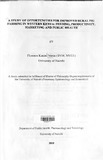| dc.description.abstract | An integrated study to investigate rural pig farming practices was conducted in selected sublocations ofBusia and Kakamega Districts, Western Kenya from June 2006 to October 2008. Six Focused Group Discussions (FGD) were conducted in Kakamega District before beginning farm visits. A total of 288 pig farms were visited three times in the course of the study period. Data on pig management and feeding were gathered using questionnaires administered in face-to-face interviews. Pigs were weighed and length and girth body measurements were taken using tape measures (em). Pigs were tested for Cysticercus cellulosae cysts using the lingual palpation. Two sets oftraining workshops were conducted after the initial farm visit.
Discussions during the FGD were taped, transcribed and translated from Swahili to English. Data were analyzed qualitatively using MaxQDA software; analyses involved identifying common themes. Women were responsible for the care of pigs while men played a key role in the selling. Pigs were the easiest animals to sell because they do not need to be transported to the market since buyers come to the farms. Poor market channels, poor breeds, inadequate government support, inadequate animal health support, diseases, and cultural and religious differences were some of the challenges identified during the discussions.
From the study it was found that more women (69 %; 512 / 735) than men were interviewed during the farm visits. The interviewees' age distributions were: <30 yrs 34 % (250 / 735); 30 - 50 yrs 44 % (327 / 735) and >50 yrs (23 %; 158 / 735). Only 2 % (12 / 735) of the respondents had completed college education and approximately half (54 %; 400 / 735) were Catholics. Farmers owned on average 2.33 (±2.01) acres of land; this ranged from 0.125- 10 acres. The mean
Number of nursing, growing and breeding pigs owned per farm were 5.0 (±3.4), 1.8 (±1.2) and 1.5 (±O.9), respectively. Pork was consumed by 74 % (212 / 288) of the farmers. It was the most preferred of all the meats by 39 % (49 / 124) and 27% (42 / 154) (p=0.003) of the farmers in Kakamega and Busia Districts, respectively.
Most (73 %; 209 / 288) farms had no pig house because: they believed this was not necessary (8 %; 16/209); there was no time to build a pig house (13 %; 28 / 209); the farmer lacked the skill (11%; 23 /209); the farmer lacked money to buy construction materials (45 %; 93 / 209). More pig houses were observed in Kakamega than in Busia District (OR=5.4; CI 3.1-9.7). Pig-level and household-level prevalence of porcine cysticercosis were 4 % (52 / 1290) and 15 % (43 / 288) respectively.
A total of 840 pigs were weighed during the study, including 363 young ts 5 months), 305 market age (5.1-9 .9 months) and 172 breeding age (2: 1 0 months) pigs. Separate weight estimation models were developed for each category of pig using a random sample of 75% of the data and then validated with the remaining 25 % of the data.
These analyses were completed using Stata® statistical software. The young, market and breeding pigs weighed on average 12 (±6), 30 (±11), and 42 (±17) kg, respectively. The ADG for young, market and breeding pigs were 93 (±52) g, 125 (±58) g and 101 (±80) g, respectively. The weight estimation models were as follows: young pig weight = [0.18 (length) + 0.36 (girth) - 16]; market-age pig weight = [0.39 (length) + 0.64 (girth) -48]; breeding pig weight = [0.36 (length) + 1.02 (girth)-74]. The length and girth explained 88% - 91 % of the total variation in pig weight.
The mean age at which sows farrowed for the first time was 12 months (±5.4) while the mean number of litters born to a sow before she was sold was 1.04 (±0.21). Average number of pigs born alive and weaned per litter were 7.85 (±2.55) and 6.61 (±3.25) respectively. Pigs were at:S 4 weeks (56 %; 182/324),5 - 8 weeks (36%; 117/324), or >8 weeks (8 %; 25 / 324) of age. The average price for weaned piglets was Ksh 619 (±174); however, this price was lower in Busia (Ksh 509) than in Kakamega (Ksh 777) (p< 0.05). Farmers described challenges of pig keeping as: feeding (65 %; 479/736); diseases (46 %; 342/ 736); few breeding boars (60 %; 444/736); getting little money from the sale of pigs (61 %; 450/ 736); and pigs as causes of conflicts with neighbours (53 %; 395 / 736). Farmers in Busia (53 %; 231 / 434) were more likely to experience pig disease problems than farmers in Kakamega District (36%; 111/302) (OR=I.95, CI 1.4 - 2.6).
The most frequently fed foodstuffs were cooked maize (Uga/i) (88 %; 404/455), kitchen left overs (83 %; 382/455), dried fish (omena) %; 357 / 455), sweet potatoes (75 %; 343 / 455), sweet potato vines (65 %; 298 / 455), (57 %; 262 / 455), brewers waste which was the mash left from home made beer . (machicha) (48 %; 220/455), maize (33 %; 151 /455) and innards from fish (30 %; 138/455). About 37 % (46 / 124) of farmers in Kakamega and 40 % (65 / 164) of those in Busia provided their pigs with waste water from household kitchen use. The mean age of pig farmers who attended the farmer training was higher (40.3± 14.0) compared to the mean age for those farmers who had missed the training (35.4±12.7) (p<0.05).
Feeding pigs balanced diets was the most frequently (52 %; 62 / 118) reported lesson learnt by the farmers during the workshops. Western Kenya is an important sector with rich potential to alleviate rural poverty.The current study provided baseline data on sow productivity, feeding management and constraints that were previously inadequate. The study has further highlighted a number of challenges that need to be addressed before reasonable gains in small-holder pig farming are realized. | en_US |

